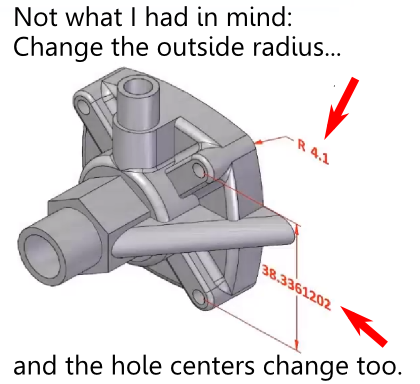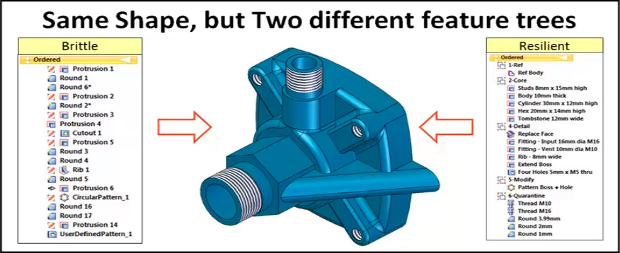 What is the failed promise of parametric CAD? In short, model reuse.
What is the failed promise of parametric CAD? In short, model reuse.
It’s a lot more difficult than it ought to be, for a variety of reasons. Several months back, I wrote a series of articles discussing those reasons, as well as some of the solutions that have come up over the years. What was missing from the series was a final chapter; a detailed description of what could prove to be a viable solution to problems with model reuse: the resilient modeling strategy.
The resilient modeling strategy (RMS) is the brainchild of Richard “Dick” Gebhard. I wrote about Dick last June, in the article A Resilient Modeling Strategy. He’s a low-key guy with deep experience and serious expertise in the practical use of MCAD software. Over his career in CAD, he’s been a reseller for CADKEY, Pro/E, and most recently, Solid Edge.
RMS is a best practice for creating CAD models that are stable and easily reusable (even by inexperienced users.) It can be learned and easily used by typical CAD users, it preserves design intent in models, and provides a mechanism by which managers or checkers can quickly validate a model’s quality.
When Dick first started thinking about the concepts that make up the resilient modeling strategy, it was natural that it was in the context of showing the advantages of Synchronous Technology (The Siemens PLM brand name for its version of direct modeling.) In our discussions about RMS over the last year or so, I pointed out that, while I thought that RMS did indeed demonstrate the benefits of hybrid history/direct modeling in Solid Edge, for it to be taken seriously, and not be unfairly dismissed as a marketing initiative for Solid Edge, it needed to work with a wide variety of MCAD tools. I think Dick got where I was coming from, because he’s continued to refine and generalize RMS, with feedback from users of a number of MCAD systems.
In its current incarnation, RMS works particularly well with Solid Edge, as might be expected, but also works very well with Creo, NX, CATIA, and IronCAD (all of which are hybrid history/direct systems.) Further, with a few modifications, it can provide compelling value with SolidWorks, Inventor, and Pro/E (all of which are primarily history-oriented systems.)
It’s significant that RMS is also free to use. While Dick is available to provide presentations, seminars, and training, he has not attempted to patent, or keep as trade secrets, the underlying concepts of RMS. (He does claim a trademark on the term “Resilient Modeling Strategy,” which means that organizations offering commercial training on RMS will need to get Dick’s OK to use the term.)
Dick has posted an introductory presentation on RMS at resilientmodeling.com. While the entire presentation is 20 minutes long, the first 3-1/2 minutes cover the problems that people invariably experience when reusing or editing history-based CAD models. Watching that much will likely convince you to watch the rest.
On Wednesday, November 20, at 10:00 AM PST, Dick will be hosting a webinar on RMS. It’s scheduled to last just 30 minutes, with the emphasis on content, not hype. If you’re a serious CAD user or a CAD manager (or, for that matter, you work for an MCAD developer), it’ll be well worth your time to attend.
TL;DR: Resilient Modeling Strategy is a best practice for creating high quality reusable 3D MCAD models. It works with many CAD systems, it’s easy to learn and use, and it’s free. Big payoff for MCAD users.
Presentation at resilientmodeling.com
Register for Nov 20 webinar on Resilient Modeling



Mike and Dick have done a good job explaining what happens in the “real world” of design and the pitfalls that happen during design- not knowing what design intent is until the part/product has been completed. The arguments are real and the solutions are valid.
I’m not sure I would call this strategy “new”. After viewing the presentation, the topics and part organization are very similar to what was/is the NX best practices that have been taught in the past- ever since we could group feature and rename them.
I will say that the authors do a great job by providing the tools and strategy to support the best practices- which in my opinion are in dire need.
Overall, I agree, great strategy. My thanks to the authors for taking the time to prepare and deliver this information to the masses.
Nothing is new under the sun. Most of the concepts here are simply best practices, used in a variety of CAD systems. RMS is simply a distillation.
It’s definitely not about “new”. It’s about how many people and organizations can’t model properly and the damage this has done and continues to do. If anything this problem is now very widespread. In my not so humble opinion this problem has gotten far worse in the last five years.
This presentation is the best I’ve ever seen at laying out a systematic approach to ending over 25 years of insanity. The question CADCAM users should be asking is why did it take so long for a free presentation like this to be released to the masses? I know the answer but most people don’t want to deal with my answer because it says so much about how truly screwed up the CADCAM business is.
The answer is that this is really a CADCAM marketing problem and an educational problem:
Most people who are CADCAM jockeys can’t teach to save their life and their design intent it often horrible.
CADCAM companies like UGS, now Siemens, DS/SolidWorks, etc. want to charge big bucks for training where they might provide this information.
I’ve been around CADCAM for over 20 years now. I’ve seen too much to not know what the truth is. The CADCAM industry needs an overhaul and lots of fresh new bodies need to replace the dead wood who didn’t and still can’t get the job done.
Jon Banquer
CADCAM Technology Leaders group on LinkedIn.
It would be interesting to see if RMS could be applied to the BIM modeling world and programs like REVIT. Like parametric CAD, BIM is a mostly failed promise, BIM software is mostly overpromised and underdelivered but a concept with great potential.
I did a click through on your link next to your photo Jon and went to your website. Great explanation there of the pitfalls of traditional modeling.